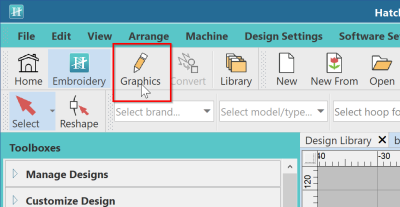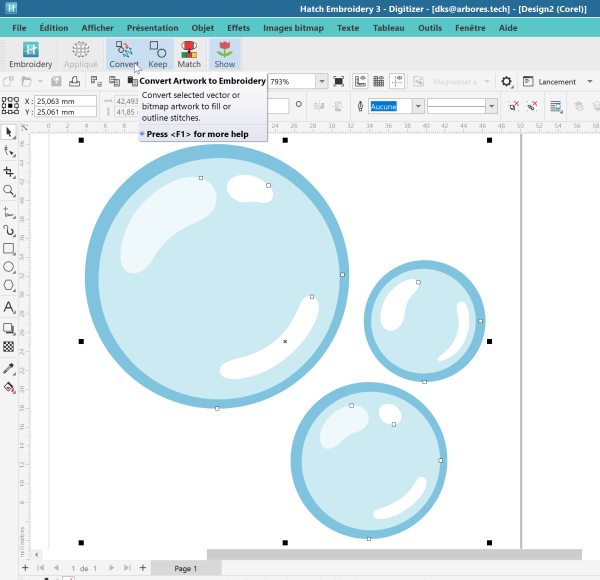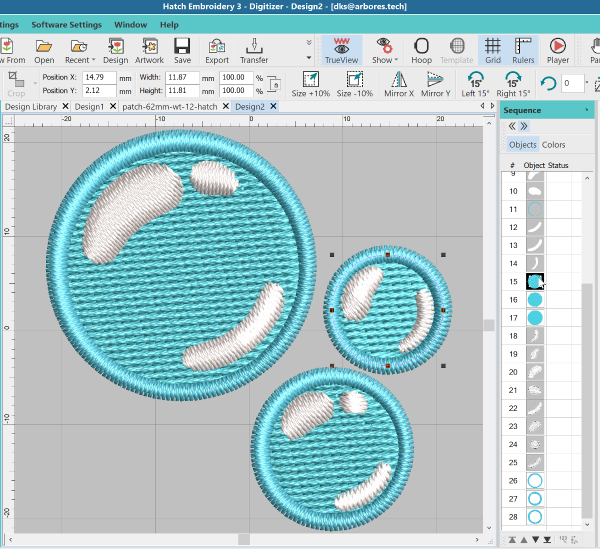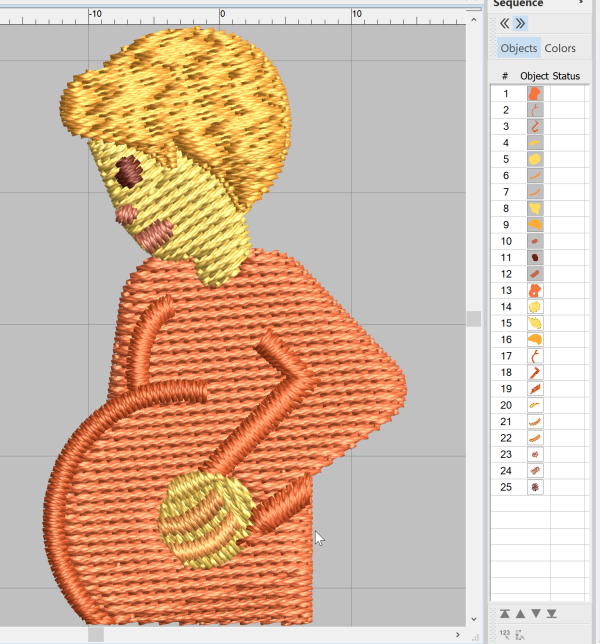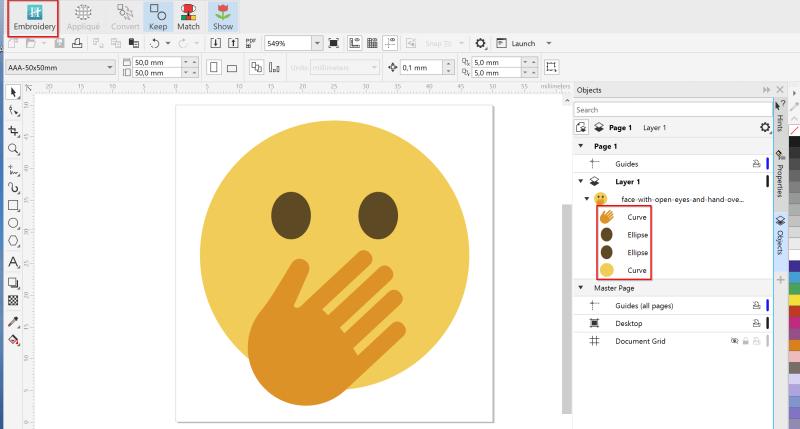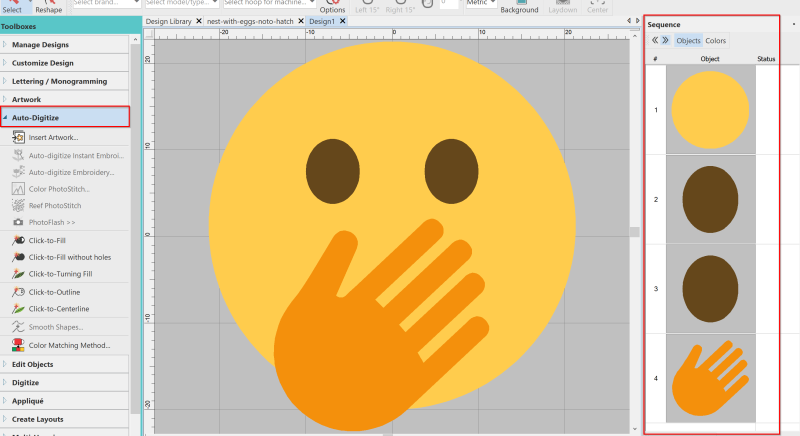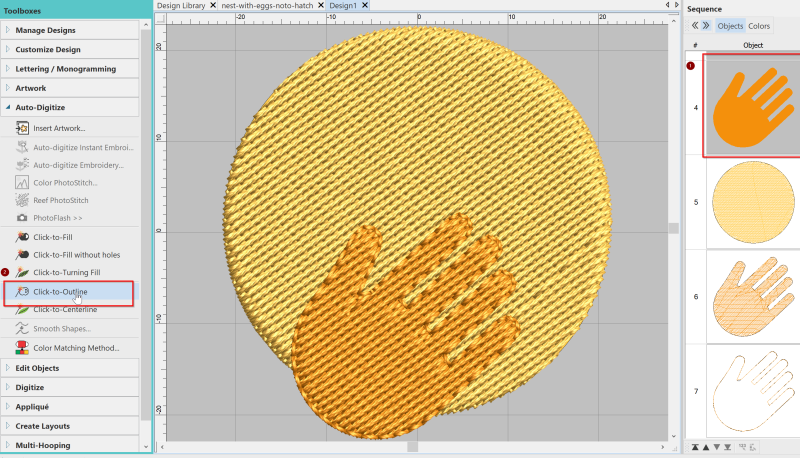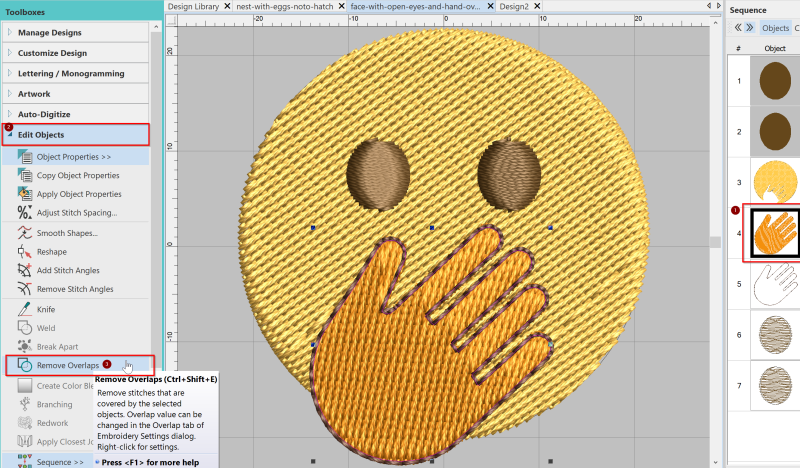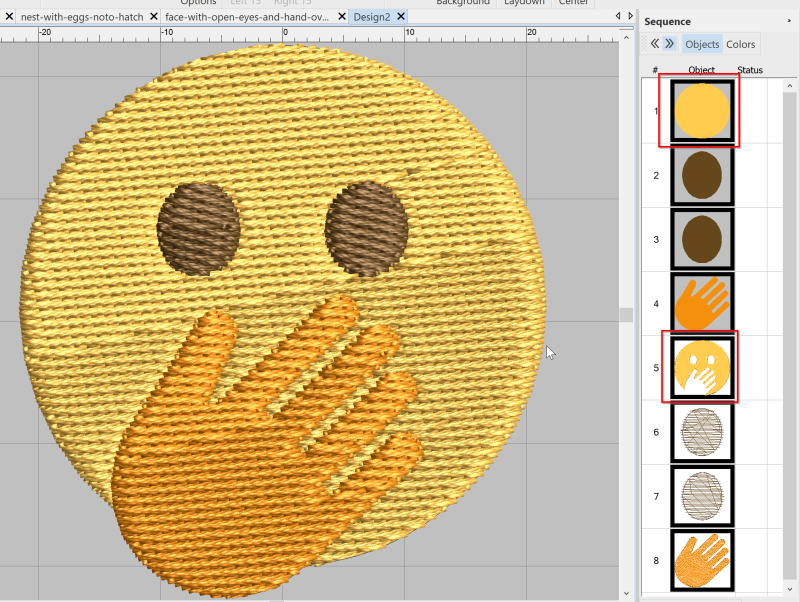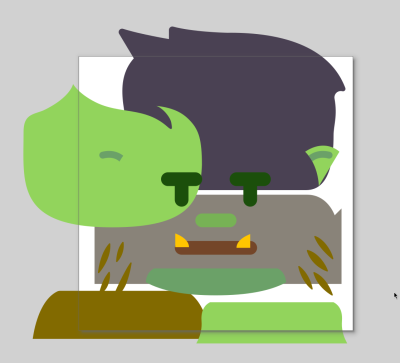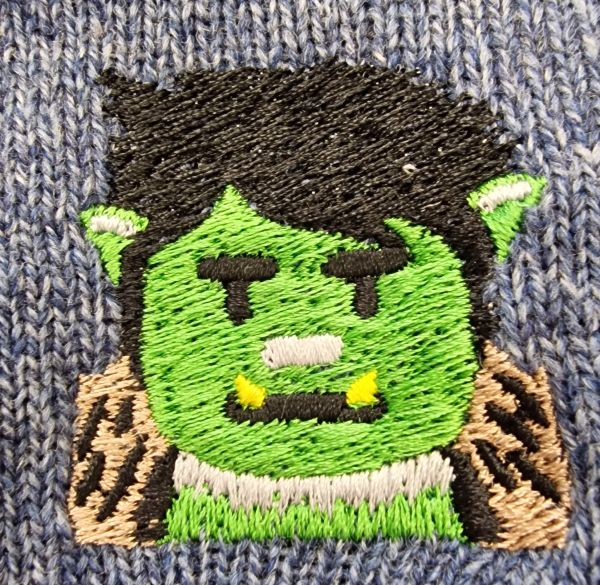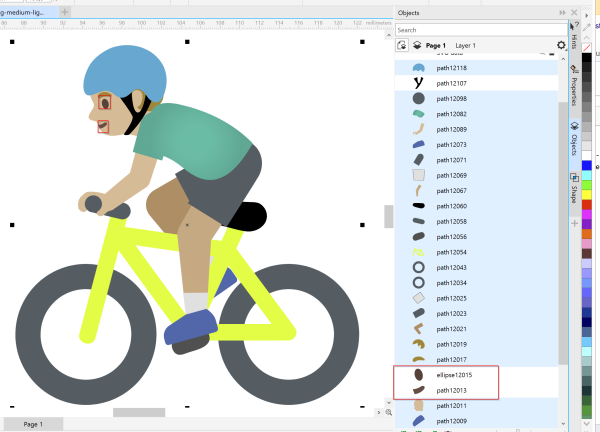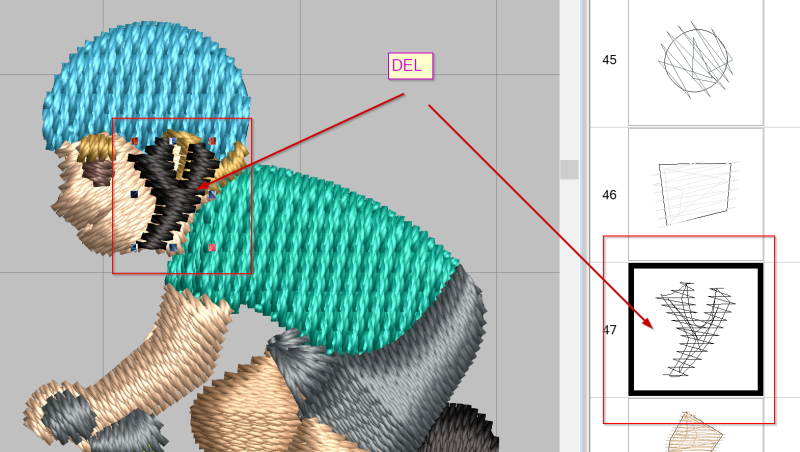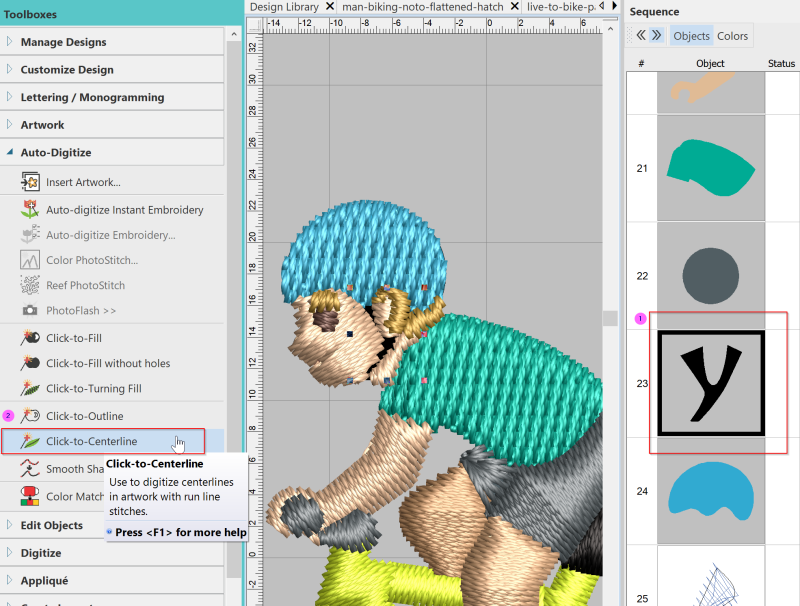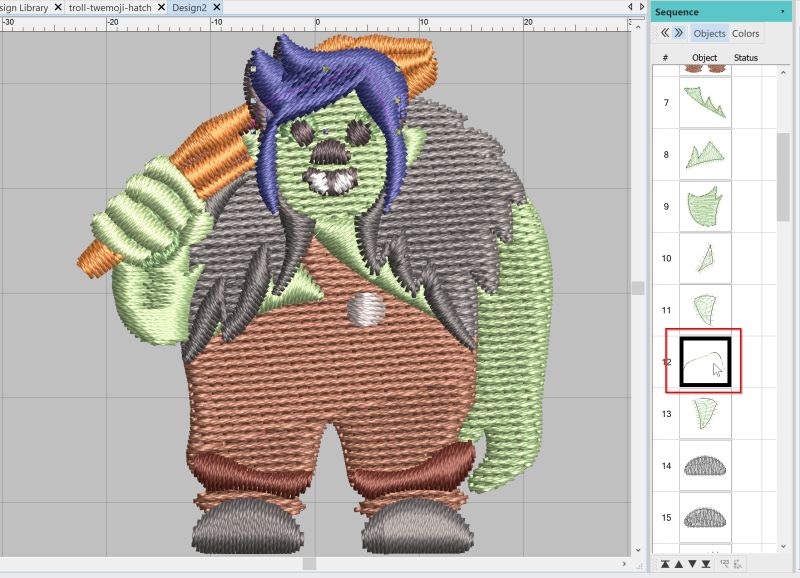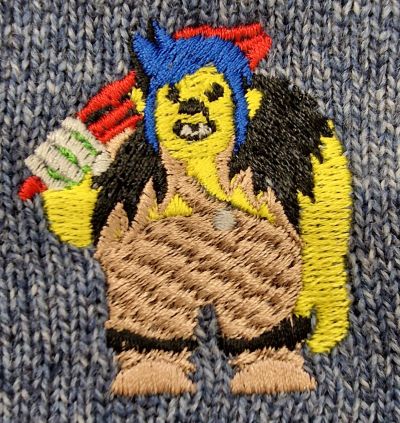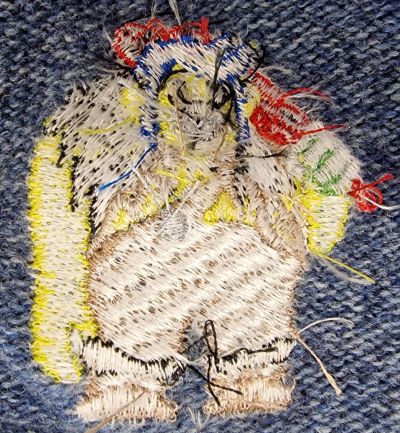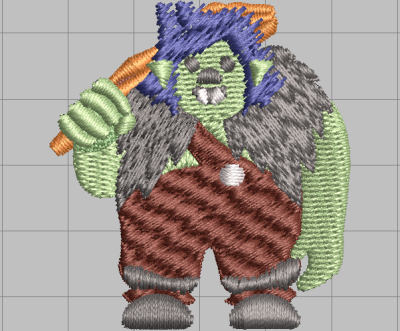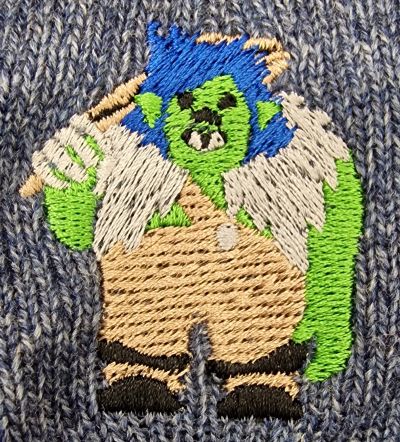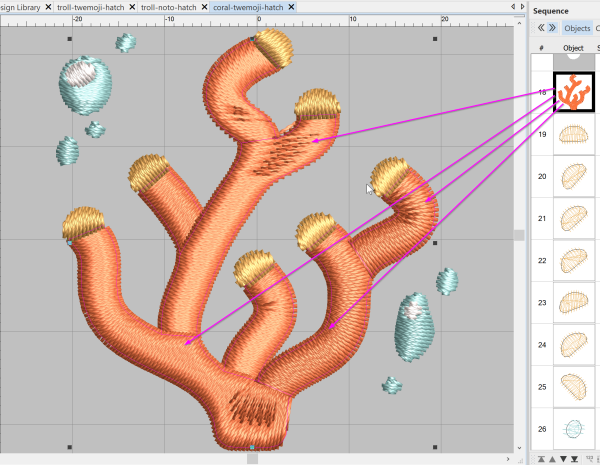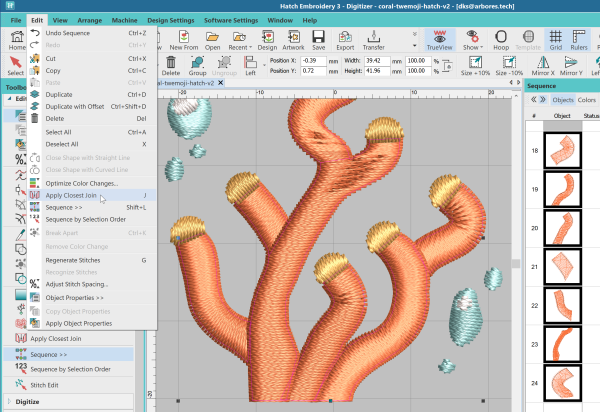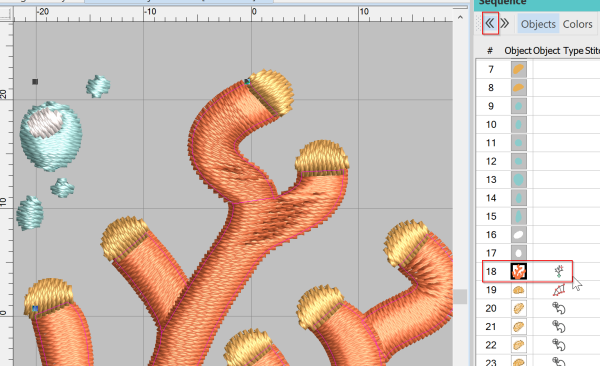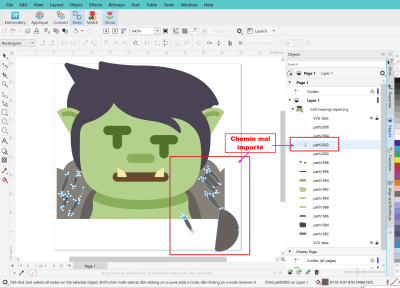CorelDRAW GEM for Hatch Embroidery: Difference between revisions
mNo edit summary |
mNo edit summary |
||
| Line 23: | Line 23: | ||
[https://hatchembroidery.com/coreldraw/CorelDRAW GEM for Hatch Embroidery] is an "add on" for the [[Hatch Embroidery]] embroidery software. It includes the 2021 Standard edition of Corel Draw plus the interface. In Switzerland, its price is $249 including VAT. In France, it will be necessary to add a VAT. A priori it can be installed on three computers and used on one at a time. | [https://hatchembroidery.com/coreldraw/CorelDRAW GEM for Hatch Embroidery] is an "add on" for the [[Hatch Embroidery]] embroidery software. It includes the 2021 Standard edition of Corel Draw plus the interface. In Switzerland, its price is $249 including VAT. In France, it will be necessary to add a VAT. A priori it can be installed on three computers and used on one at a time. | ||
This extension allows you to manipulate vector designs and digitize them into embroidery objects. The "standard" edition of Corel Draw is a good drawing tool. The "add-on" includes an automatic digitizing procedure of the drawing (or selected objects) which includes a mechanism to eliminate large overlaps. Then, you can also use Hatch's auto-digitizing tools to transform vector paths imported into Hatch into embroidery objects. These features are very '''handy for scanning logos, emoji or other | This extension allows you to manipulate vector designs and digitize them into embroidery objects. The "standard" edition of Corel Draw is a good drawing tool. The "add-on" includes an automatic digitizing procedure of the drawing (or selected objects) which includes a mechanism to eliminate large overlaps. Then, you can also use Hatch's auto-digitizing tools to transform vector paths imported into Hatch into embroidery objects. These features are very '''handy for scanning logos, emoji or other clip-art in vector format''' (SVG, AI, CDR, etc.). They '''are also suitable for graphic designers who prefer to first create a precise design''' before transforming its elements into embroidery objects. | ||
That said, compared to software like Stitch Era which integrates drawing software, the features of the Hatch3 - Corel Draw "bridge" are relatively poor: | That said, compared to software like Stitch Era which integrates drawing software, the features of the Hatch3 - Corel Draw "bridge" are relatively poor: | ||
* In automatic conversion mode, you can just select one, several or all vector objects, then request a conversion. Hatch then automatically decides on the arrangement, the type of filling to choose, the removal of any overlaps or not, etc. Finally, if we preserve the vector objects, we can delete the resulting embroidery object, then use the "click-to-..." procedure to re-digitize (read [[Hatch Embroidery | * In automatic conversion mode, you can just select one, several or all vector objects, then request a conversion. Hatch then automatically decides on the arrangement, the type of filling to choose, the removal of any overlaps or not, etc. Finally, if we preserve the vector objects, we can delete the resulting embroidery object, then use the "click-to-..." procedure to re-digitize (read [[Hatch Embroidery 3 - auto-digitizing|here]] ). This is particularly interesting for digitizing certain fine objects with a "center-line" method. | ||
* In semi-automatic digitizing mode, vector objects can be digitized one by one, or in groups. As there is a bug in "Remove Overlaps" which allows to manage overlays in embroidery objects, we advise to manage overlays beforehand in Corel. | * In semi-automatic digitizing mode, vector objects can be digitized one by one, or in groups. As there is a bug in "Remove Overlaps" which allows to manage overlays in embroidery objects, we advise to manage overlays beforehand in Corel. | ||
| Line 33: | Line 33: | ||
In our opinion, the "CorelDRAW" add-on is very useful in situations where you want to base an embroidery on a vector drawing, either to gain precision, or to be able to recover various "clipart" (icons, fonts, logos , images) or to reuse various drawings. | In our opinion, the "CorelDRAW" add-on is very useful in situations where you want to base an embroidery on a vector drawing, either to gain precision, or to be able to recover various "clipart" (icons, fonts, logos , images) or to reuse various drawings. | ||
A "free" alternative to purchasing this module is to export vector designs to high resolution PNG and then use the semi-automatic method described [[Hatch Embroidery | A "free" alternative to purchasing this module is to export vector designs to high resolution PNG and then use the semi-automatic method described [[Hatch Embroidery 3 - auto-digitizing|here]]. To prepare the drawing and the export in PNG, one can use the software [[Inkscape]] (free). | ||
== Setup == | == Setup == | ||
| Line 57: | Line 57: | ||
We will use the English interface for the simple reason that the French documentation is very incomplete. There is no manual .... | We will use the English interface for the simple reason that the French documentation is very incomplete. There is no manual .... | ||
You can access the drawing module ( | You can access the drawing module (CorelDraw) via a new "Graphics" button at the top left next to the "Embroidery" button. We will use the latter to return to the embroidery functionalities. These buttons can be hidden in a drop-down menu (under "Home") if you haven't stretched this panel. | ||
[[image:hatch3-coreldraw-0.png|none|thumb|400px|Hatch 3 with Corel Draw]] | [[image:hatch3-coreldraw-0.png|none|thumb|400px|Hatch 3 with Corel Draw]] | ||
| Line 73: | Line 73: | ||
We will digitize the "bubbles" emoji (new in version 14) with a 100% automatic procedure. | We will digitize the "bubbles" emoji (new in version 14) with a 100% automatic procedure. | ||
[[image:bubbles-noto.clipart.svg|none|thumb|400x400px| | [[image:bubbles-noto.clipart.svg|none|thumb|400x400px|link=Special:FilePath/Bubbles-noto.clipart.svg]] ([[Media:Bubbles-noto.clipart.svg]], download from SVG page, save with CTRL-S in your browser) | ||
The procedure for automatically converting vector objects into Hatch embroidery objects is simple: | The procedure for automatically converting vector objects into Hatch embroidery objects is simple: | ||
| Line 117: | Line 117: | ||
'''Scanning''' | '''Scanning''' | ||
We proceed more or less as described in the article [[Hatch Embroidery 2 - automatic digitizing]], except that the options are a little more limited. Click-to-fill will not create holes, since the selected element has none. So you have to deal with overlays later. | We proceed more or less as described in the article [[Hatch Embroidery 3 - auto-digitizing|Hatch Embroidery 2 - automatic digitizing]], except that the options are a little more limited. Click-to-fill will not create holes, since the selected element has none. So you have to deal with overlays later. | ||
To digitize a vector object, choose it in the sequence panel, then select the digitizing method. The following image shows scanning the hand with a tatami mat. | To digitize a vector object, choose it in the sequence panel, then select the digitizing method. The following image shows scanning the hand with a tatami mat. | ||
| Line 146: | Line 146: | ||
Here is the simulated result: | Here is the simulated result: | ||
[[image:face-with-open-eyes-and-hand-over-mouth-hatch.png|none|thumb|800px|Simulation face-with-open-eyes-and-hand-over-mouth]] | [[image:face-with-open-eyes-and-hand-over-mouth-hatch.png|none|thumb|800px|Simulation face-with-open-eyes-and-hand-over-mouth|link=Special:FilePath/Face-with-open-eyes-and-hand-over-mouth-hatch.png]] | ||
Files: | Files: | ||
| Line 166: | Line 166: | ||
Here is the principle explained and tested with the Troll emoji of the Twemoji font of Twitter. | Here is the principle explained and tested with the Troll emoji of the Twemoji font of Twitter. | ||
[[image: troll-twemoji.clipart.svg|none|400px|thumb|Emoji SVG, twemoji font]] | [[image: troll-twemoji.clipart.svg|none|400px|thumb|Emoji SVG, twemoji font|link=Special:FilePath/Troll-twemoji.clipart.svg]] | ||
Notice: To import this drawing correctly, it was necessary to first break some paths with InkScape (c.f. the section importing SVG) below). In Corel Draw, you can break an object with | Notice: To import this drawing correctly, it was necessary to first break some paths with InkScape (c.f. the section importing SVG) below). In Corel Draw, you can break an object with | ||
| Line 188: | Line 188: | ||
Here is the simulated and embroidered result: | Here is the simulated and embroidered result: | ||
[[image: troll-twemoj-hatch.PNG|none|600px|thumb|Emoji Troll (twemoji) digitized]] | [[image: troll-twemoj-hatch.PNG|none|600px|thumb|Emoji Troll (twemoji) digitized|link=Special:FilePath/Troll-twemoj-hatch.PNG]] | ||
[[image: troll-twemoj-hatch.JPG|none|600px|thumb|Troll emoji (twemoji) digitized]] | [[image: troll-twemoj-hatch.JPG|none|600px|thumb|Troll emoji (twemoji) digitized|link=Special:FilePath/Troll-twemoj-hatch.JPG]] | ||
The result is correct, nothing more. | The result is correct, nothing more. | ||
| Line 205: | Line 205: | ||
Here is an example of a Noto cyclist (man biking) emoji | Here is an example of a Noto cyclist (man biking) emoji | ||
[[image:man-biking-medium-light-skin-tone.svg|none|thumb|600px|Noto Police Man biking emoji]] | [[image:man-biking-medium-light-skin-tone.svg|none|thumb|600px|Noto Police Man biking emoji|link=Special:FilePath/Man-biking-medium-light-skin-tone.svg]] | ||
[[image:corel-draw2021-manage-overlaps-1.png|none|thumb|600px|Overlays to eliminate]] | [[image:corel-draw2021-manage-overlaps-1.png|none|thumb|600px|Overlays to eliminate]] | ||
| Line 225: | Line 225: | ||
== Rescan elements == | == Rescan elements == | ||
Despite a well-prepared design, the result can be disappointing. In this case, you can re-digitize with the "auto-digitize" tools that we have already introduced above and that are usually used to digitize raster designs (see [[Hatch Embroidery 2 - automatic digitizing]]). | Despite a well-prepared design, the result can be disappointing. In this case, you can re-digitize with the "auto-digitize" tools that we have already introduced above and that are usually used to digitize raster designs (see [[Hatch Embroidery 3 - auto-digitizing|Hatch Embroidery 2 - automatic digitizing]]). | ||
So to rescan an object you have to: | So to rescan an object you have to: | ||
| Line 252: | Line 252: | ||
The Google/Android troll (Noto font) is more complex than the twitter one (see above). A priori, it would be necessary to enlarge the size of the embroidery a little compared to the previous pattern, but we will keep our standard dimensions of 45mm max. high or wide. Overall, auto-digitizing a complex drawing gives mixed results. It is better to simplify the drawing beforehand. | The Google/Android troll (Noto font) is more complex than the twitter one (see above). A priori, it would be necessary to enlarge the size of the embroidery a little compared to the previous pattern, but we will keep our standard dimensions of 45mm max. high or wide. Overall, auto-digitizing a complex drawing gives mixed results. It is better to simplify the drawing beforehand. | ||
[[image: troll-noto.clipart-ori.svg|none|400px|thumb|Emoji SVG, Noto font (Android)]] | [[image: troll-noto.clipart-ori.svg|none|400px|thumb|Emoji SVG, Noto font (Android)|link=Special:FilePath/Troll-noto.clipart-ori.svg]] | ||
We slightly simplified the original in InkScape (we could also have done it easily in Corel Draw). In particular, we have: | We slightly simplified the original in InkScape (we could also have done it easily in Corel Draw). In particular, we have: | ||
| Line 258: | Line 258: | ||
* enlarged eyes, mouth, teeth. | * enlarged eyes, mouth, teeth. | ||
[[image: troll-noto.clipart.svg|none|400px|thumb|Simplified SVG emoji, Noto font (Android)]] | [[image: troll-noto.clipart.svg|none|400px|thumb|Simplified SVG emoji, Noto font (Android)|link=Special:FilePath/Troll-noto.clipart.svg]] | ||
The result of the automatic digitization is correct, but requires adjustments. | The result of the automatic digitization is correct, but requires adjustments. | ||
| Line 270: | Line 270: | ||
* Changed some direction lines | * Changed some direction lines | ||
[[image: troll-noto-hatch.PNG|none|400px|thumb|Noto troll emoji digitized with Hatch (tentative)]] | [[image: troll-noto-hatch.PNG|none|400px|thumb|Noto troll emoji digitized with Hatch (tentative)|link=Special:FilePath/Troll-noto-hatch.PNG]] | ||
A first version is not convincing: too many details and too many knots as a result. In addition, we forgot part of the hair (Hatch did not digitize an unclosed object). | A first version is not convincing: too many details and too many knots as a result. In addition, we forgot part of the hair (Hatch did not digitize an unclosed object). | ||
[[image: troll-noto-hatch.JPG|none|400px|thumb|Embroidered Noto troll emoji (V1)]] | [[image: troll-noto-hatch.JPG|none|400px|thumb|Embroidered Noto troll emoji (V1)|link=Special:FilePath/Troll-noto-hatch.JPG]] | ||
[[image: troll-noto-hatch2.JPG|none|400px|thumb|Embroidered Noto troll emoji (V1), too many bows on the back]] | [[image: troll-noto-hatch2.JPG|none|400px|thumb|Embroidered Noto troll emoji (V1), too many bows on the back|link=Special:FilePath/Troll-noto-hatch2.JPG]] | ||
We have therefore simplified everything in the embroidery module. The hair is one object, only the pupils of the eyes, etc., remain. | We have therefore simplified everything in the embroidery module. The hair is one object, only the pupils of the eyes, etc., remain. | ||
[[image: troll-noto-hatch-v2.PNG|none|400px|thumb|Noto troll emoji digitized with Hatch (simplified)]] | [[image: troll-noto-hatch-v2.PNG|none|400px|thumb|Noto troll emoji digitized with Hatch (simplified)|link=Special:FilePath/Troll-noto-hatch-v2.PNG]] | ||
New embroidered version. The result is flexible, so it won :) | New embroidered version. The result is flexible, so it won :) | ||
[[image: troll-noto-hatch3.JPG|none|400px|thumb|Embroidered Noto troll emoji (V2), drinkable]] | [[image: troll-noto-hatch3.JPG|none|400px|thumb|Embroidered Noto troll emoji (V2), drinkable|link=Special:FilePath/Troll-noto-hatch3.JPG]] | ||
Files: | Files: | ||
* troll-noto... in [http://tecfa.unige.ch/guides/embroid/emoji/AAA_EMOJIS/people_body/person-fantasy/ this | * troll-noto... in [http://tecfa.unige.ch/guides/embroid/emoji/AAA_EMOJIS/people_body/person-fantasy/ this directory] | ||
Morale: Automatic digitizing of complex drawings may require simplification work before or after automatic digitizing. This is also our experience with other embroidery software. Finally, in 8X8cm automatic scanning would probably have given a better result. So the complexity is also to be managed according to the size of the pattern. | Morale: Automatic digitizing of complex drawings may require simplification work before or after automatic digitizing. This is also our experience with other embroidery software. Finally, in 8X8cm automatic scanning would probably have given a better result. So the complexity is also to be managed according to the size of the pattern. | ||
| Line 295: | Line 295: | ||
Here's the Coral example (also a new version 14 emoji): | Here's the Coral example (also a new version 14 emoji): | ||
[[image:coral-twemoji.clipart.svg|none|thumb|400px|Twitter Font Coral Emoji]] | [[image:coral-twemoji.clipart.svg|none|thumb|400px|Twitter Font Coral Emoji|link=Special:FilePath/Coral-twemoji.clipart.svg]] | ||
[[image:hatch3-coreldraw-8.png|none|thumb|600px|scan result]] | [[image:hatch3-coreldraw-8.png|none|thumb|600px|scan result]] | ||
Revision as of 17:34, 29 August 2022
This article or section is currently under construction
In principle, someone is working on it and there should be a better version in a not so distant future.
If you want to modify this page, please discuss it with the person working on it (see the "history")
Intro
GEM for Hatch Embroidery is an "add on" for the Hatch Embroidery embroidery software. It includes the 2021 Standard edition of Corel Draw plus the interface. In Switzerland, its price is $249 including VAT. In France, it will be necessary to add a VAT. A priori it can be installed on three computers and used on one at a time.
This extension allows you to manipulate vector designs and digitize them into embroidery objects. The "standard" edition of Corel Draw is a good drawing tool. The "add-on" includes an automatic digitizing procedure of the drawing (or selected objects) which includes a mechanism to eliminate large overlaps. Then, you can also use Hatch's auto-digitizing tools to transform vector paths imported into Hatch into embroidery objects. These features are very handy for scanning logos, emoji or other clip-art in vector format (SVG, AI, CDR, etc.). They are also suitable for graphic designers who prefer to first create a precise design before transforming its elements into embroidery objects.
That said, compared to software like Stitch Era which integrates drawing software, the features of the Hatch3 - Corel Draw "bridge" are relatively poor:
- In automatic conversion mode, you can just select one, several or all vector objects, then request a conversion. Hatch then automatically decides on the arrangement, the type of filling to choose, the removal of any overlaps or not, etc. Finally, if we preserve the vector objects, we can delete the resulting embroidery object, then use the "click-to-..." procedure to re-digitize (read here ). This is particularly interesting for digitizing certain fine objects with a "center-line" method.
- In semi-automatic digitizing mode, vector objects can be digitized one by one, or in groups. As there is a bug in "Remove Overlaps" which allows to manage overlays in embroidery objects, we advise to manage overlays beforehand in Corel.
Then there is a good chance that the embroidery objects will have to be adapted. This implies that a design intended for embroidery is easier to digitize than a design intended for display or printing. This means, for example, that lines should be drawn as lines and not as thin polygons.
In our opinion, the "CorelDRAW" add-on is very useful in situations where you want to base an embroidery on a vector drawing, either to gain precision, or to be able to recover various "clipart" (icons, fonts, logos , images) or to reuse various drawings.
A "free" alternative to purchasing this module is to export vector designs to high resolution PNG and then use the semi-automatic method described here. To prepare the drawing and the export in PNG, one can use the software Inkscape (free).
Setup
After purchasing CorelDRAW GEM for Hatch Embroidery we get:
- a link to download Corel Draw
- a product key that you must copy. This key can be found on your online profile (http://profile.hatchembroidery.com).
Installing Corel Draw
The download results in a zip file. To install it you need:
- Unzip the *.zip file in a new folder,
- Go to the /c64 folder and click on Setup.exe
- Choose your languages to install (I prefer to use software in English). If you forget this step, you must restart the installer.
- Indicate the product key when the installer asks for it.
- Register on the Corel site (allows you to recover the software and your key)
Installing the interface with Hatch
- Close Hatch and relaunch it: On launch Hatch 3 will detect Corel and ask you whether to link the two. Say "yes".
Easy to use with examples
We will use the English interface for the simple reason that the French documentation is very incomplete. There is no manual ....
You can access the drawing module (CorelDraw) via a new "Graphics" button at the top left next to the "Embroidery" button. We will use the latter to return to the embroidery functionalities. These buttons can be hidden in a drop-down menu (under "Home") if you haven't stretched this panel.
There are two methods for digitizing vector drawings:
- Automatic conversion which imports the selected objects by managing overlay, positions, etc.
- Semi-automatic conversion which consists of digitizing the objects one by one with standard Hatch tools
ch.
Of course, you can combine the two methods...
Automatic conversion
We will digitize the "bubbles" emoji (new in version 14) with a 100% automatic procedure.
(Media:Bubbles-noto.clipart.svg, download from SVG page, save with CTRL-S in your browser)
The procedure for automatically converting vector objects into Hatch embroidery objects is simple:
- Select all
- Click on
Convert
Hatch complains that it can't convert everything (because there are other objects in the SVG file), but the result is absolutely fine for automatic digitizing:
- Items are sorted in the correct order
- The bubbles in white are in satin, embroidered over the blue background
If we check (default) on <code>Keep</code>, each vector object is in the sequence (at the beginning) and we can therefore redigitize them differently using the automatic digitizing tools in Hatch (see below). On the other hand, if you want to change the shape, you have to go back to Corel, modify the element in question, then just digitize this element (don't forget to delete the old embroidery object).
Files: Search bubbles-noto-* (SVG, EMB, PES)
We digitized other simple objects, such as the "pregnant person" emoji. We just changed the texture of the hair:
Files:
- person-pregnant-... files in the folder http://tecfa.unige.ch/guides/embroid/emoji/AAA_EMOJIS/people_body/person-role/ (copyrights in the folder)
Semi-automatic conversion
This method involves importing a drawing (including making adjustments if necessary) and then using the "normal" tools for Hatch's auto digitizing.
We show this method with a "face-with-open-eyes-and-hand-over-mouth" emoticon.
Import
- Here is the image of the drawing adjusted to 45mm. We also adjusted the page size to 5x5cm (Layout -> Document Options -> Page Size).
Instead of using the automatic conversion with Convert, we return to Hatch by pressing the Embroidery button. In Hatch, we now see the same vector objects in the sequence panel (Window -> Dockers -> Sequence or SHIFT+L). In the toolbox on the left (Toolbox) we open the group Auto-Digitize
Scanning
We proceed more or less as described in the article Hatch Embroidery 2 - automatic digitizing, except that the options are a little more limited. Click-to-fill will not create holes, since the selected element has none. So you have to deal with overlays later.
To digitize a vector object, choose it in the sequence panel, then select the digitizing method. The following image shows scanning the hand with a tatami mat.
To add an outline around the hand, we do almost the same. We select the main vector object, then we select Click-to-Outline
Management of superimpositions a posteriori
A priori, it would have been more convenient to manage overlays in Corel before moving to Hatch (see later in this article), but here we show how to manipulate embroidery objects. The hand is too large to be embroidered above the face. A priori, the procedure would be a simple click on "Remove Overlaps", but Hatch misses the target, punctures the vector drawing of the face and removes the hand. As a workaround, we used the following method:
- Remove face vector drawing
Remove Overlapsand click on the "hand" embroidery object.
Here in comparison, the result of an automatic digitization with "Convert". We see that the software makes a subtraction for the face, inserts it and then digitizes this version.
The result is just as good in this case, it would just be necessary to adjust the embroidery objects.
Finishes
- We digitize the satin eyes: Select the eyes and choose
Click-to-turning-fill - Change direction of hand points
- Change the outline to dark brown, triple stitches and enlarge a bit (102%) and adjust some lines. We find it unfortunate that Hatch does not allow you to define outlines for tatami or satin column objects. Duplicating an object and enlarging it is neither precise nor fast.
Here is the simulated result:
Files:
- face-with-open-eyes-and-hand-over-mouth-hatch-... in the folder
Overlay management
One advantage of the CorelDRAW GEM "add-on" is to be able to digitize many precise drawings that exist in proprietary (AI, CDR, WMF) or open (SVG) vector format. The problem is that graphic designers use drawing techniques that overlap elements and we will have to manage that. There are several techniques for dealing with overlays:
- Hatch 3 automatically manages overlaps as already shown, i.e. in automatic conversion the software eliminates large overlaps and keeps small ones which it then digitizes in satin.
- We can have finer control if we take advantage of Corel Draw's features to eliminate them.
- Then we can also eliminate the overlaps at the level of the embroidery objects.
- Finally, you can always rescan an object in Corel or a vector object imported in Hatch. Importing often modifies the original objects.
Automatic overlay management
Hatch 3 automates the handling of overlays and seems to do a decent job as already seen in the example discussed at the start. However, we regret not being able to specify the management method as in Stitch Era which has three modes: (a) eliminate all overlaps (b) eliminate the important ones (c) eliminate nothing. Hatch automatically takes option (b) and eliminates significant overlaps.
Here is the principle explained and tested with the Troll emoji of the Twemoji font of Twitter.
Notice: To import this drawing correctly, it was necessary to first break some paths with InkScape (c.f. the section importing SVG) below). In Corel Draw, you can break an object with
The design was made with a lot of superpositions that would normally have to be eliminated, because in embroidery we avoid superimpositions, finally we can embroider satin objects on a tatami. When digitizing with InkStitch you have to do these "subtractions" manually.
With Hatch 3 we proceeded directly to the automatic digitization as in the example above.
- Select all
- Click on the
Convertbutton
Here is the result of this automatic digitization (so, we repeat, without preliminary elimination of superimpositions)
Obviously, if we wanted to keep superimpositions, we could digitize object by object, but it's a bit of a pain.
Now just make some adjustments. At a minimum, I suggest the following:
- Increase stretch compensations a bit
- Turn fills into something more troll. I used the "hand stitch" and "feather" effects.
Here is the simulated and embroidered result:
The result is correct, nothing more.
Files:
- troll-twemoji... in this folder
Control overlays in Corel Draw
It was previously shown that Hatch automatically removes large superpositions and preserves small ones. Using this all-in-one strategy sometimes works well sometimes, but sometimes badly. In the latter case, it is advisable to first prepare the drawing in Corel Draw which contains all the tools necessary to simplify.
We particularly recommend the "Simplify" tool which eliminates all the overlaps of a set of paths:
- Select all objects (or a subset)
- Choose the "simplify" tool and apply.
Here is an example of a Noto cyclist (man biking) emoji
Choose all the elements to flatten (we just avoid the eyes, the mouth and the strap that we will embroider over it
Then, choose the Simplify tool: Window > Dockers > Shaping to open the "Shaping" docker.
- Click on
Apply(checking that the right objects have been chosen)
This method removes any overlap. It is therefore necessary to check that Hatch is set for
- add overlay (default = 1mm in embroidery properties)
- additionally add stretch compensation
An alternative strategy is to export this image as a very high resolution PNG and semi-automatically digitize it element by detected element as explained in automatic digitization.
Rescan elements
Despite a well-prepared design, the result can be disappointing. In this case, you can re-digitize with the "auto-digitize" tools that we have already introduced above and that are usually used to digitize raster designs (see Hatch Embroidery 2 - automatic digitizing).
So to rescan an object you have to:
- Select the embroidery object in question and delete it
- Open auto-digitize panel
- Select vector object to rescan
- Choose the right method
Here's an example: the headpiece strap is digitized as a satin by default when a triple stitch would be more appropriate. With an automatic "click-to" digitizing method one can digitize it as a line:
Digitizing relatively complex objects
The art of digitizing from vector drawings is largely about simplifying the drawings. Remember that the resolution with normal wire (weight 40) is 0.2mm. This does not allow to create fine designs.
A second problem concerns the already discussed overlays, a third concerns the complex polygons which often translate badly. This is particularly the case of the icons that can be found on the site of noun project which contains hundreds of thousands of icons that can be used as clipart.
Simplify a troll
The Google/Android troll (Noto font) is more complex than the twitter one (see above). A priori, it would be necessary to enlarge the size of the embroidery a little compared to the previous pattern, but we will keep our standard dimensions of 45mm max. high or wide. Overall, auto-digitizing a complex drawing gives mixed results. It is better to simplify the drawing beforehand.
We slightly simplified the original in InkScape (we could also have done it easily in Corel Draw). In particular, we have:
- eliminated small objects, e.g. double pupils, double furs, double buttons,
- enlarged eyes, mouth, teeth.
The result of the automatic digitization is correct, but requires adjustments.
Here are some quick changes:
- Killed 3-4 unnecessary lines (see screenshot above)
- Changed the fillings of some tatami
- Added "hand stitch" effect, especially to some satins
- Changed some direction lines
A first version is not convincing: too many details and too many knots as a result. In addition, we forgot part of the hair (Hatch did not digitize an unclosed object).
We have therefore simplified everything in the embroidery module. The hair is one object, only the pupils of the eyes, etc., remain.
New embroidered version. The result is flexible, so it won :)
Files:
- troll-noto... in this directory
Morale: Automatic digitizing of complex drawings may require simplification work before or after automatic digitizing. This is also our experience with other embroidery software. Finally, in 8X8cm automatic scanning would probably have given a better result. So the complexity is also to be managed according to the size of the pattern.
Import complex polygons
Designers often create sprawling objects by unifying paths. One method to better manage these drawings is to break the objects, before or after importing. Here we will break the embroidery object.
Here's the Coral example (also a new version 14 emoji):
This result will probably stitch well, but we can do better
- either we break this object and adjust the shapes
- either we do some vector surgery, but we couldn't find a manual that explains how to manage these partitions
Break (separate) an object
A composite object (eg a wired object) can be broken into components. So we shattered the object, and then with the "Reshape" tool pulled and manipulated the stems at the bottom by deleting points, enlarging the shapes by dragging control points, etc.
Then, we apply "apply closet joins" which brings the entry/exit points closer together. We could do better by creating paths that avoid creating jumps (another time)
Recomposing a complex object by branching
Finally, we can recreate a composite object. We suggest using "Branching" in the "Digitize" tab and not "Weld" in the "Edit Objects" tab.
Here is the result, to see that an object is "connected" you have to change the display of the sequence.
Files:
- "coral-..." files in the folder http://tecfa.unige.ch/guides/embroid/emoji/AAA_EMOJIS/animals_nature/animal-marine/
Basic Corel Draw manipulations
Page size
We strongly advise to define the size of the page, before importing a design and defining the dimensions of your embroidery hoop.
It is possible to save your favorite templates by clicking on the save icon. So for example AAA-50x50mm for a small frame.
- In the English version: Menu Layout -> Page Layout
Display and selection
Zoom:
- Zoom on the whole drawing: F4
Selection:
- Selection of an object in a group: CRTL-click
- Edit nodes: 2nd icon in the tools panel on the left (other tools are hidden below, same logic as at Adobe, so be careful).
Panels
As in many software of this type, many operations are done through specialized panels. Here are the most important:
- Show objects: Window menu->Docker->Objects. Then you have to click on the root which has the name of the file,
- Align and Distribute: CTRL-SHIFT-A opens the panel
- Transformation: ALT-F7
Import from SVG
For some drawings, the import result is not very good. If this is the case, it is advisable to open to do at least the following two things:
- break paths that contain separate objects. Normally you should use
Object -> Break Apart(CTRL-K) but it doesn't always work. In this case we use "break apart (CTRL-SHIFT-K in InkScape. - close open polygons.
If you are more proficient in another software, such as Inkscape or Illustrator, use that. I use InkScape as a rule.
Then you have to decide whether to reduce the overlaps
- The "simplify" tool (Window > Dockers > Shaping) flattens a set of objects (neither InkScape nor Illustrator can do this if I'm not mistaken). See the example of the cyclist discussed above.
Otherwise, it is also advisable to think about reducing the colors. Anyway in InkScape I always work with a reduced palette which roughly matches the embroidery threads I use. To see how to manage colors in Corel and Hatch....
Bugs
- Import complex SVG paths (see above)
- Break apart does not work with sub-objects that are in the same path (curve): Solution = use InkScape. This said, these inseparable objects can scan well.
- If you make a manipulation without having placed an imported object (press ENTER), it is destroyed
- CTRL-Z repeated beyond Corel and Hatch firm mods :(
- Same if you import a drawing and try to save the still empty EMB file.
Links
- The add-on sales page GEM for Hatch Embroidery has a short video explaining how the integration works.
